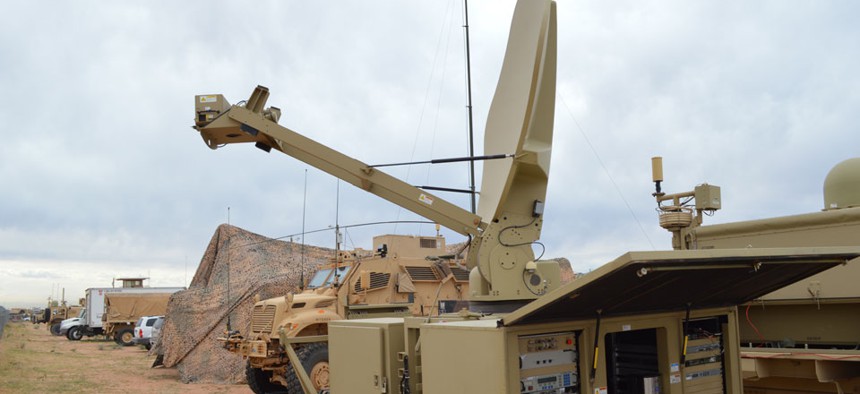Mobile Command Post Saves Hours at Army Network Exercise

Soldiers train with a new tactical communications node at Network Integration Evaluation 14.1 at Fort Bliss in October. Defense Department
Powerful simulation systems replicate 12,000 troops.
FORT BLISS, Texas – Frustrated with the time it took to set up a tent-based tactical command post for the 2nd Brigade, 1st Armored Division (2/1 AD) during the Army Network Integration Evaluation exercise here last year, Col. Thomas Dorame decided his soldiers could build a speedily deployed unit inside a tactical van.
After a frustrating experience that included his troops “nailing tables to the floor” inside a van, the 2/1 AD commander said in a briefing for Nextgov that he took up an offer to have the Army System of Systems Integration Directorate do the job instead.
The result: a new mobile command post for the current NIE based on a Light Medium Tactical Vehicle van with expandable sides. This van accommodates a command staff with six to eight computer workstations and monitors the progress of a battle on four large computer monitors at the front of the van.
Fiber optic cables snake across the desert floor to an adjacent Mine-Resistant Ambush Protected vehicle that Staff Sgt. Wilberto Sierra said houses four computer servers acting as 12 virtual servers. Another set of fiber optic cables connects the server MRAP to another MRAP equipped with the Warfighter Information Network-Tactical satellite and terrestrial communications systems.
Dorame said this vehicle-based system can be packed up and ready to move in about 45 minutes, a sharp cut from the four hours required for the tent-based command post. He wants to replace the disk drive-based servers – which need to be powered up after a move – with solid state servers to cut another 15 minutes off of the setup time.
The command post sits at the top of a network pyramid for the 3,700 soldiers from the 2/1 AD engaged in the NIE, the sixth semi-annual exercise to test Army battlefield networks. These soldiers communicate over 18 unclassified networks, and 52 classified networks with a total of 655 tactical radios and 179 spectrum assignments, said Lt. Col. Lawrence Karl, the officer in charge of the Network Operations Center for the NIE.
Armored vehicles at this NIE range from the oldest in the Army inventory -- the M113 armored personnel carrier fielded in 1962 -- to one of the newest, the wheeled Stryker, which went into operation in 2005.
Besides his troops, Dorame also commands another 12,000 Army and Marine troops thanks to a simulation system powered by a rack of computer servers in a nondescript building on the main post here.
Mike McCarthy, director of simulation operations and program manager for the Army Brigade Modernization Command, said the 22 simulation servers handle 1.3 million calculations per second, representing 1st Infantry Division, five subordinate Brigades and a Marine regiment. The servers, McCarthy said, also replicated an enemy force of more than two divisions, operating in a battle space about twice the size of the state of Connecticut.
The simulation system fed maneuvers of all these troops into the 2/1 AD command and control system – including map overlays – with such fidelity that Dorame could not tell the difference between real and simulated forces, McCarthy said.
Simulation, McCarthy said, offered the Army “huge cost avoidance savings” as simulated troops do not require food, water tents or porta-potties.
Dorame, a West Point graduate and a career tanker since 1988, can reel off computer lingo as well as a computer specialist. Asked if he imagined 20 years ago he would be engaged in conversation replete with references to Internet protocol addresses, Dorame laughed and said, “I did not imagine a year ago I would be talking about IP addresses.”
But, Dorame said, “If you are the commander of a formation, you need to understand what you need to accomplish the mission. I’m in a cyber-fight, and I need to understand the network.”
NEXT STORY: Why Obamacare Is On Life Support



